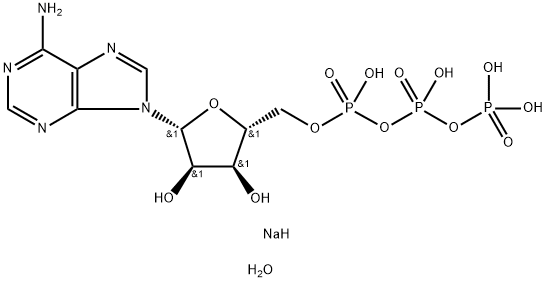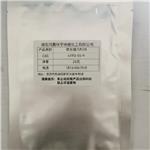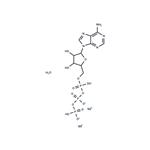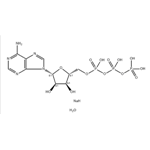Description
Adenosine-5'-triphosphate disodium salt hydrate is used for the detection of fatty acids, caffeine, and chemiluminescent assays. Adenosine 5'-triphosphate disodium salt hydrate can be used to measure the hydration level of cells by using a chemiluminescent assay. Adenosine 5'-triphosphate disodium salt hydrate has also been shown to promote pro-inflammatory cytokines such as IL-6 and IL-8 secretion from macrophages.
Chemical Properties
White fine crystalline powder
Uses
Adenosine 5′-triphosphate (ATP) is a central component of energy storage and metabolism in vivo. ATP is use in many cellular processes, respiration, biosynthetic reactions, motility, and cell division. ATP is a substrate of many kinases involved in cell signaling and of adenylate cyclase(s) that produce the second messenger cAMP. ATP provides the metabolic energy to drive metabolic pumps. ATP serves as a coenzyme in a wide array of enzymatic reactions.
Uses
Adenosine 5γ-triphosphate (ATP) is a central component of energy storage and metabolism in vivo. ATP is use in many cellular processes, respiration, biosynthetic reactions, motility, and cell division. ATP is a substrate of many kinases involved in cell signaling and of adenylate cyclase(s) that produce the second messenger cAMP. ATP provides the metabolic energy to drive metabolic pumps. ATP serves as a coenzyme in a wide array of enzymatic reactions.
Uses
Adenosine-5'-triphosphate disodium salt hydrate is used as a form of cellular energy. It is used in many cellular processes, respiration, biosynthetic reactions, motility, and cell division. ATP is a substrate of many kinases involved in cell signaling and of adenylate cyclase(s) that produce the second messenger cAMP. ATP provides the metabolic energy to drive metabolic pumps. ATP serves as a coenzyme in a wide array of enzymatic reactions.
General Description
Adenosine 5γ-triphosphate (ATP) is a central component of energy storage and metabolism
in vivo. ATP is used in many cellular processes, respiration, biosynthetic reactions, motility, and cell division. ATP is a substrate of many kinases involved in cell signaling and of adenylate cyclase(s) that produce the second messenger CAMP. ATP provides the metabolic energy to drive metabolic pumps.
Biochem/physiol Actions
P2 purinergic agonist; increases activity of Ca2+-activated K+ channels; substrate for ATP-dependent enzyme systems





